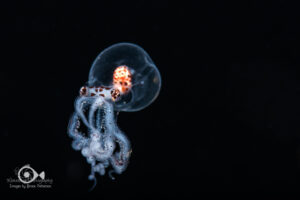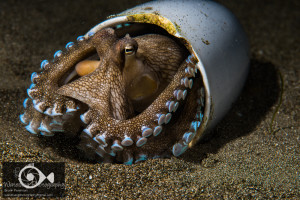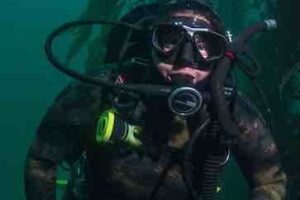To some, scuba diving may seem like an extreme sport, while others view it as a relaxing activity. But a new adrenaline rush is emerging in the scuba community as one of the “must do” activities in the sport, especially among underwater photographers. It is called Blackwater diving.

Blackwater diving causes apprehension, even among the most seasoned scuba divers because it is done at night, often miles from shore in water that can be hundreds of meters deep. Divers who embark on a blackwater dive must be advanced divers, with good buoyancy skills and should have experience with current.

There are several different procedures that dive operators follow, but most involve dropping a rope over the side of the boat that is weighted at the bottom. Bright lights may be tied along the length of the rope to attract oceanic animals and divers may or may not be tethered to this rope. The rope may be tied to the boat, or it may be tied to a lighted buoy. Divers can hover around the lights at a depth of just a few meters to well over 30 meters if their training allows. However, most will find the top 20 meters of water has plenty to see.

The thrill of a dive like this starts in the heart of a first-timer with questions like “what if I can’t control my buoyancy and I sink too deep?” Or, “what if there is a current that sweeps me away from the boat?” And if the imagination is very active, “Don’t I look like bait dangling off a rope in the middle of the ocean at night?” These concerns are valid as there is certainly some danger involved. However, with careful planning, that danger can be minimized, and the dive can be spectacular.

The draw of blackwater diving is the opportunity to see animals that are not viewed by the average scuba diver. Blackwater diving is not just doing a dive at night. When the sun sets, larval and planktonic animals rise from deep water to feed in the water column. These animals are very tiny, ranging in size from a few millimeters up to several centimeters. They are mostly clear as they are developing and often they do not look anything like they will when they become adults. In many cases they just look plain weird because some of their developing parts may be on the outside of their bodies, or easily observed because of a translucent membrane. Once these animals begin their juvenile phase, they can be found in ID books and may look more familiar. Many scuba divers are involved in the sport because they enjoy seeing marine life and blackwater diving delivers an experience unlike anything else.

For divers who are less experienced, or want a more controlled environment, the first step may be a bonfire dive. Bonfire diving is done at night in water that has a bottom within recreational dive limits. Several lights are planted on the ocean floor pointing upward to attract planktonic and larval animals. The divers hover just outside the beam of light facing the open ocean and watch for interesting critters to float by. For many, this is a good first step because there is more security in knowing where the bottom is, and in being close to shore.

On a bonfire dive, animals are more likely to be in a larval state as they are closer to settling on the bottom or reef for good. Most ocean animals start their life as plankton except for mammals and sharks. Eggs are swept out into open ocean water where they begin to develop away from the hungry mouths of reef fish and other small animals that stay close to shore. As they grow, some will begin to return to the shallower waters where they will be able to find food themselves as adults. Others will spend their entire lives floating on the current in open ocean. Animals that are seen both on bonfire dives and blackwater dives can be larval or planktonic squid, shrimps, octopus, jellyfish, pyrosomes, nautilus, fish, crabs, lobsters and more.

Because blackwater diving is a relatively new sport, it is not offered at every dive destination. It is becoming popular in Kona, Hawaii (USA,) Anilao, (Philippines,) and Jupiter, Florida (USA) as well as a few other destinations such as Ambon and Bali. Divers should discuss the method that is employed by the dive operator before embarking on a dive to make sure they are comfortable and have the right equipment. Blackwater and bonfire diving can be an exciting adventure for even the most experienced scuba divers. Remember to put your safety first and then enjoy the ride.

Join me for a workshop! Travel to a great destination where you will have exclusive coaching on your underwater photography. Meet new people, network, try new techniques, and learn with the pros! Click on Travel and Workshops for more information!
Subscribe now!
As always, if you enjoy my images please visit my website, waterdogphotography.com, or give me a like on Facebook at Waterdog Photography Brook Peterson. Don’t forget to follow me here at waterdogphotographyblog and please feel free to share on Facebook or other social media.
My photographs are taken with a Nikon D810 in Sea and Sea Housing using two YS-D2 Strobes.
All images and content are copyrighted by Brook Peterson and may only be used with written permission. Please do not copy or print them. To discuss terms for using these images, please contact me.
copyright Brook Peterson 2019





